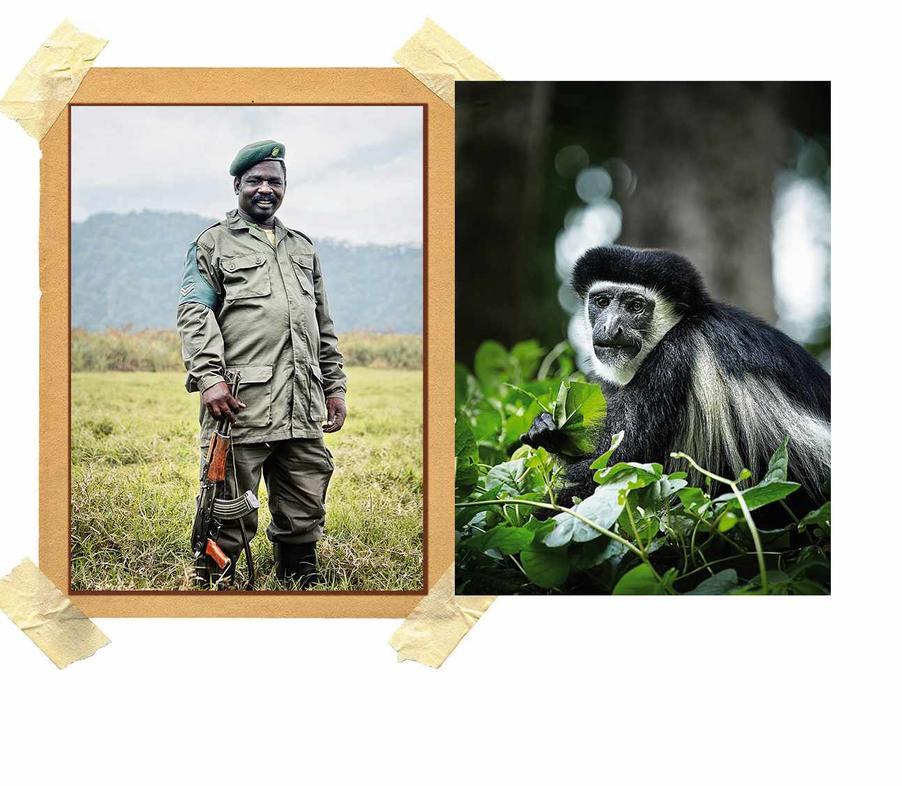
16 minute read
TALES OF TANZANIA
from jhgfyuffybu
LEFT Ranger Mutosha Sabath in Ngurdoto Crater; a colobus monkey on the crater rim
The monster that lived in a volcano
Advertisement
“And that’s how it happened, at night, in total darkness. They were sleeping near the fire on the ground. Then there was this hot breath on his face and this pain when finger-long fangs cut into his neck and his face. And then his lower jaw broke. Just for a glimpse, he opened his eyes and saw something huge and black with amber-coloured eyes…” * *Story told by the Meru tribe in Arusha
Mutosha Sabath leads us down an old elephant trail, parting leaves the size of surfboards with his rifle and batting aside giant cobwebs. The hornbills now float high above, their rasping calls sounding increasingly malevolent. We reach the bottom after a scrambling descent, and two stout Cape buffalo are there to meet us. ‘If they charge,’ whispers Mutosha edging around them, ‘lie down. They think you are a log and jump over.’ There is no need to test his theory in the swampy pools at our feet – the buffalo sniff the air, and trot off into the forest.
There is a special trepidation-filled wonder knowing we are the only human life in that deep hole. Sudden movements and rustling in the reeds raise the hairs on the back of our necks, but Ngurdoto’s wildlife, not much used to sharing its home, is keeping itself hidden from Homo sapiens for another day. Of Gurumica, there is no sign. ‘A monster?’ says Mutosha, frowning when I relay the story. ‘I have been a ranger here for nearly
The green cup of Ngurdoto Crater seems benign enough viewed from its rim. A pair of silver-cheeked hornbills lifts off from the branches of a mahogany tree, and is carried by thermals over the void, the reed beds of the crater floor indistinct and hazy 300m below. Around the edge, families of colobus monkeys, their black and white fur like ragged tailcoats, pick at the leaves of strangler figs, glancing up as our jeep slides past on a red track slippery from recent rain.
The crater, 15 million years old and the collapsed caldera of an ancient volcano, has been known to the outside world for barely a hundred years, and humans were not allowed to set foot there for most of that time: if ever there was a corner on Earth where a mysterious beast with amber eyes and fangs as long as fingers could hide away from mankind, Ngurdoto is it. But we won’t know for certain from up here; to find out if Gurumico, the fabled monster of local legend, exists, we must descend to the crater floor.
20 years, and I have never seen a monster. The big danger here is the washa washa plant – when it stings, it is more serious than the bee!’ As if to prove the point, he immediately stumbles back into the leaves of the plant and hops away howling, slapping at his legs like a demented morris dancer.
Ngurdoto may prefer to guard its mysteries, but the rest of Arusha, the national park of which it is part, has no such reservations. To the north, Big Momella Lake is a grunting, flapping, squawking merry-go-round of pink. Thousands of flamingos drift on the water, beaks open to scoop up algae from the surface. One is occasionally spooked and runs along the water to take off, soon followed by hundreds of others. They circle the lake for a few laps before some unknown signal assures them it’s safe to plop down once more into the lake. On the grasslands around Momella, gangly giraffes and barrelbodied zebras amble with uneasy grace. They stand their ground momentarily when a safari jeep trundles past, curiosity getting the better of them, before lolloping away in search of cover.
Mount Meru towers over Arusha, its peak seldom revealed through the clouds. Baboons squat in the road that wiggles up the mountain, staring down vehicles with contempt before swaggering into the trees. As we ascend, purple-flowered cassia trees give way to junipers and cedars wrapped in dark moss and curling swirls of mist. With the gradient too steep, we continue on foot and are soon in a boggy crater strewn with small black balls of lava, clumps of red-hot pokers waving in the breeze. Long ago on this spot, the flamingos of Momella a thin, pink strip far below, the local Meru tribe would offer a goat to their god Njeku in exchange for abundant rainfall or a fecund marriage. Returning the next day to find nothing but bones, they concluded their prayers had been answered. We don’t have a goat to sacrifice, but a deposit of fresh leopard droppings on the trail back to the jeep lets us know that we have not been alone on the mountain.
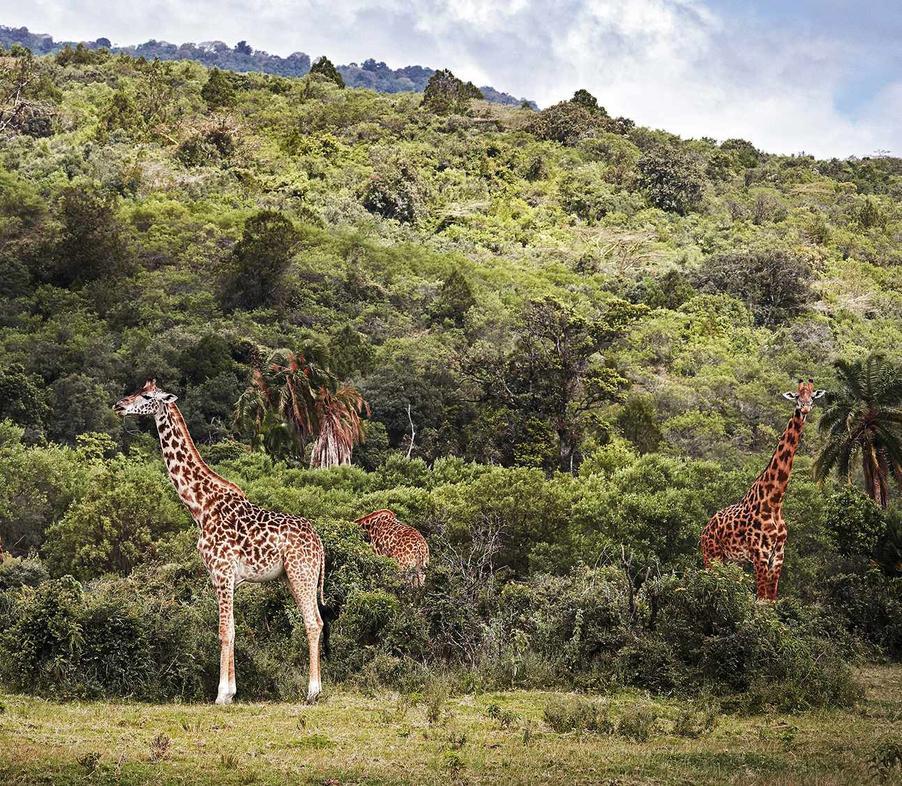
LEFT A Maasai boy leads his cows down to the singing well; a 60-year-old male elephant in South Amboseli
The elephant that found a singing well
“It had not rained for many months and the village was thirsty. The chief followed a herd of elephants and saw that they always went to the same spot. He knew the elephants were very wise and could sense water deep in the ground. He started to dig, and after many days reached water.”* *South Amboseli folklore

Dust devils whip across Southern Amboseli, the only stirring in the slow, thick heat of afternoon. Most sensible creatures have found a bush or burrow to shelter in, waiting for the sun to set and turn the distant, snow-capped peak of Mount Kilimanjaro violet in the process. Song drifts across the plains, a strange melody of male voices and clanging bells. But there is no sign of the source.
Then, the cattle appear, pouring out of the earth as though they have been spat out of it. Small boys, in the traditional shuka robes of the Maasai, follow, whacking the cows on their bony haunches with a slender stick. Behind them, down a tunnel that runs twenty feet through the hard dry rock, more cattle still jostle at a water trough. Young Maasai men, braided hair painted red and silver jewellery rattling, stand knee-deep in a murky pool, tossing plastic buckets of water up towards them. They holler and shout in rhythm with the work, voices raised against the dong-a-long of cattle bells.
At the well’s entrance, resting in the shade of a yellow acacia, is Lolepo Lesongoi. Effortlessly regal with long dangling earlobes and an electric blue shuka, he is the son of the chief who, according to local folklore, found the ‘singing well’ by observing the wise old elephants. He laughs. ‘Elephants are our friends, and we are happy to share our land and our water with them – but they did not find this well for us.’ He stops to wave flies from his face. ‘My father found a small hole and started to dig. Back then, everyone thought he was crazy!’
If the elephants can take no credit for the well, they certainly benefit from its discovery. Lolepo sometimes finds them down here at night, drinking so much they almost drain the pool entirely. They are encountered all over the savannah, hulking great lumps plodding across the grey earth or somnolently swaying as they methodically tear the branches from acacia trees and feed them into their mouths with their trunks. It’s said they come to Southern Amboseli to find quiet at the end of their lives, away from the noise and the fuss of the more popular Amboseli National Park just north of the border in Kenya.
There are worse places to retire. As the day starts to fade, more animals emerge from their hiding places. Sandgrouse and yellow-necked francolins flee from the path as we bounce along towards them in our jeep. In the long grass, a herd of zebra stand snorting before turning tail and galloping off in a whirl of dust. At a safe distance, they stop and stare once more, ears twitching. Members of the antelope world dart into view, zigzagging in front of us as though caught in an invisible pinball machine.
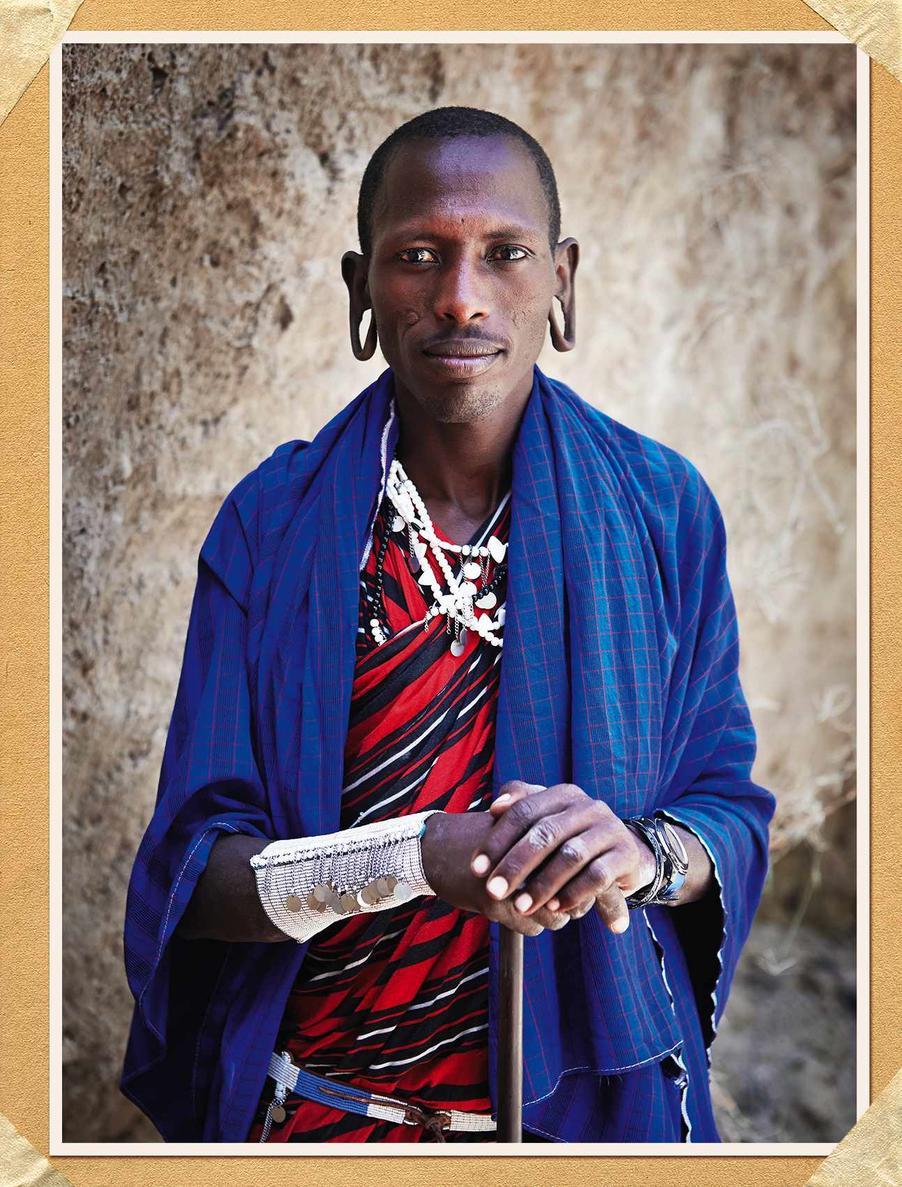
A male lion stirs from his slumber in the 600m-deep Ngorongoro Crater – a naturally bounded wildlife sanctuary.

There are tiny dik-diks, elegant impala and Thomson’s gazelles, a look of permanent astonishment on their faces. A silver-backed jackal squats in the grass, watching as a young Maasai leads his goats across the savannah. He rises to his feet and slinks forward, eyes fixed on a sick animal limping at the back of the flock. The boy spots him, and yells, and the jackal is soon gone, trotting away in search of an easier kill.
Dusk is rush hour in the Southern Amboseli; the plain is filled with people heading home after a long day in the bush. Boys meander along with their goats, cows and donkeys; girls carry stacks of firewood or jerry cans of water on their heads. At the gates of their villages, mothers wait, babies on hips, making sure they return safely.
At Boma Ya Lesongoi, a collection of thatched clay houses ringed by a fence of thorn trees, Laizer M Laizer watches as the last child meanders in. A tall Maasai with a ready smile and elaborately decorated hair, Laizer has recently gone through the coming-of-age ritual that all Maasai boys face to become a warrior. As a sign of his status, he has thrown off the black robes of the initiate and exchanged them for red. ‘Before, if you kill a lion you were a great warrior,’ he says. ‘Everyone will know you. It is like Wayne Rooney in your country.’ Warriors no longer kill lions, but theirs is no empty symbolism. ‘A warrior is a big person in our culture,’ explains Laizer, adjusting his many necklaces. ‘Like the elephant, we have a lot of power. But we must use it wisely. We all must share one life.’
As the gates of Ya Lesongoi are pulled shut, keeping out the wilds of East Africa for another night, there’s probably an elephant out there, drinking from a singing well, who wholeheartedly agrees. Every night at 6pm sharp, the gates of Ngorongoro Crater are also slammed shut, and all human life is banished.
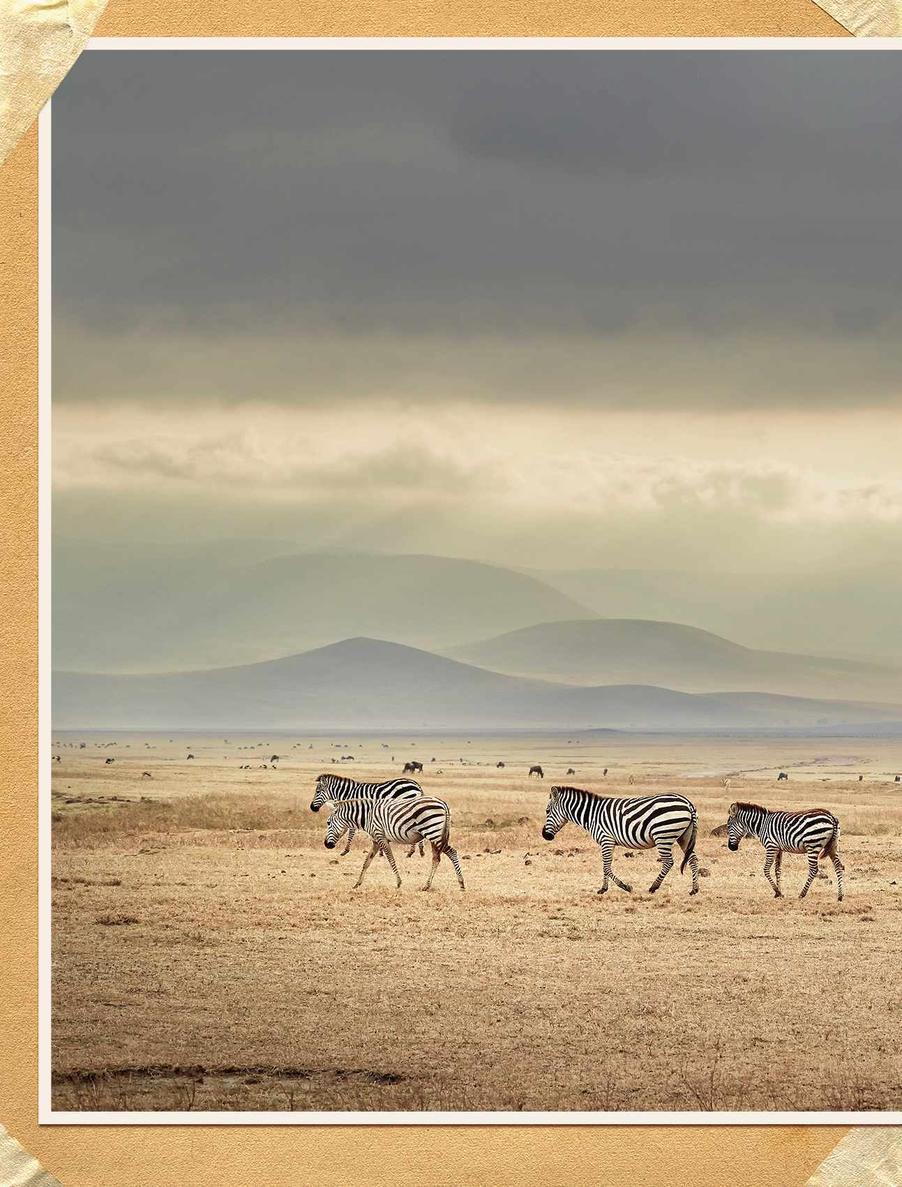
The hyena that turned into a lion
Shenzi: “You know, if it weren’t for those lions, we’d be runnin’ the joint.” Banzai: “Yeah. Man, I hate lions.”* *The hyenas’ complaint, The Lion King
Tourists return to their lodges on the rim, sharing tales of the day by the firelight, huddling under blankets as the temperature plummets. As each heads to their bed, under a sky filled with an impossible spread of stars, the stage is set for another performance down there in the deep, dark abyss. All of life and death is ready to play out in a single night – with no human audience to witness it.
By the time Ngorongoro’s gates swing open again at 6am, the sun is beginning to shoo away the clouds resting in the crater’s bowl. The park stretches out 600 metres below – a watercolour smear of beiges, greys and yellows, tiny black dots scattered haphazardly across it. The first of the morning’s safari jeeps trickle down the bumpy track to the valley floor. As we lurch along, the crater starts to take shape: those smears become small patches of woodland, lakes and grassland. The dots turn into zebra, wildebeest, hippo, elephant, Cape buffalo and kudu. It’s all of the Garden of Eden held in a single, 11-mile-wide basin.
But it’s as if we arrived in that paradisiacal garden after a particularly heavy night. Fat lions sprawl on their backs, legs in the air, occasionally winching open a golden eye to assess the progress of the day. Hippos loll in lakes, the more energetic specimens rolling 360 degrees in the water, exposing their pink bellies to the
A herd of zebra traipses across the flat grasslands of Ngorongoro Crater in a never-ending quest for grazing and water

The view from the crater rim of Ngorongoro, a Unesco World Heritage site, formed when a volcano collapsed between two and three million years ago

ABOVE FROM LEFT An ostrich on the look-out for a mate in Ngorongoro; guide Mudy Nuru tracks wildlife from his jeep
sun. Pelicans parachute down into the water and drift aimlessly, as if trying to remember why they’d come.
In the morning after the night before, all bets are off between predator and prey. Lines of endlessly plodding zebra and wildebeest pass unconcerned by hyena and lions, and share the same banks at salt licks and waterholes. Mudy Nuru trains his binoculars on a lone hyena skulking through a herd of hartebeest. ‘There is food, there is water, there are minerals here,’ he says. ‘All the animals, they have to live together. The prey knows when the predators are in hunting mode and when they are not.’ Like actors in a play, it seems they resume their roles as hunter and hunted only when an agreed sign is given.
A wildlife guide in Ngorongoro for 16 years, Mudy has observed much unexpected behaviour in the crater – the zebra who know they’ll be safe from predators if they run into groups of Maasai-owned cattle, the normally nocturnal serval cats who now hunt in the day. But it is the relationship between hyena and lion that has most been turned on its head. ‘The animals in the crater, they seem to do things the other way around,’ he says, watching as a female ostrich finally falls for the advances of an amorous male after a particularly extravagant courtship dance. ‘The hyenas here are better hunters than the lions. In fact, the lion is the scavenger in Ngorongoro.’
With no poaching and only Maasai herders allowed into the crater on foot, the relationship between animal and human has also warped. Lions regularly creep under safari jeeps to sleep in their shade, zebra brush past our vehicle on their commute between grassland and lake, and jackal pups boldly sit and stare from the roadside rather than turn and run. Long gone are the days of the Siedentopfs, two German brothers who set up a farm in the crater early in the 20th century, and took potshots at the rhino from their veranda and trained zebra to do the work of horses.
Come late afternoon, as shadows start to creep across the crater floor, Ngorongoro’s wildlife falls back into character. A trail of dust beyond the hippo pool announces a herd of wildebeest, two hundred or so panicked animals pounding across the plain. Behind them, Mudy points out three hyena – dark-furred, thick-necked creatures with black snouts and imposing fangs. ‘See, they are smart,’ he says. ‘They get together and disturb the wildebeest until one animal splits from the group. Then they will have it.’ The chase is soon out of sight, and we turn to watch a Kori bustard strutting through the scrubland. It spreads its giant wings and hoists itself into the sky. ‘I like animals that move,’ says Mudy with no little scorn. ‘Not lions that just lie all day.’
As we race out of Ngorongoro before the gates shut once more, we pass the lion pride for a final time. They are still fast asleep on their backs, paws aloft – dreaming perhaps of dinner, and the hyenas who so thoughtfully prepare it for them.
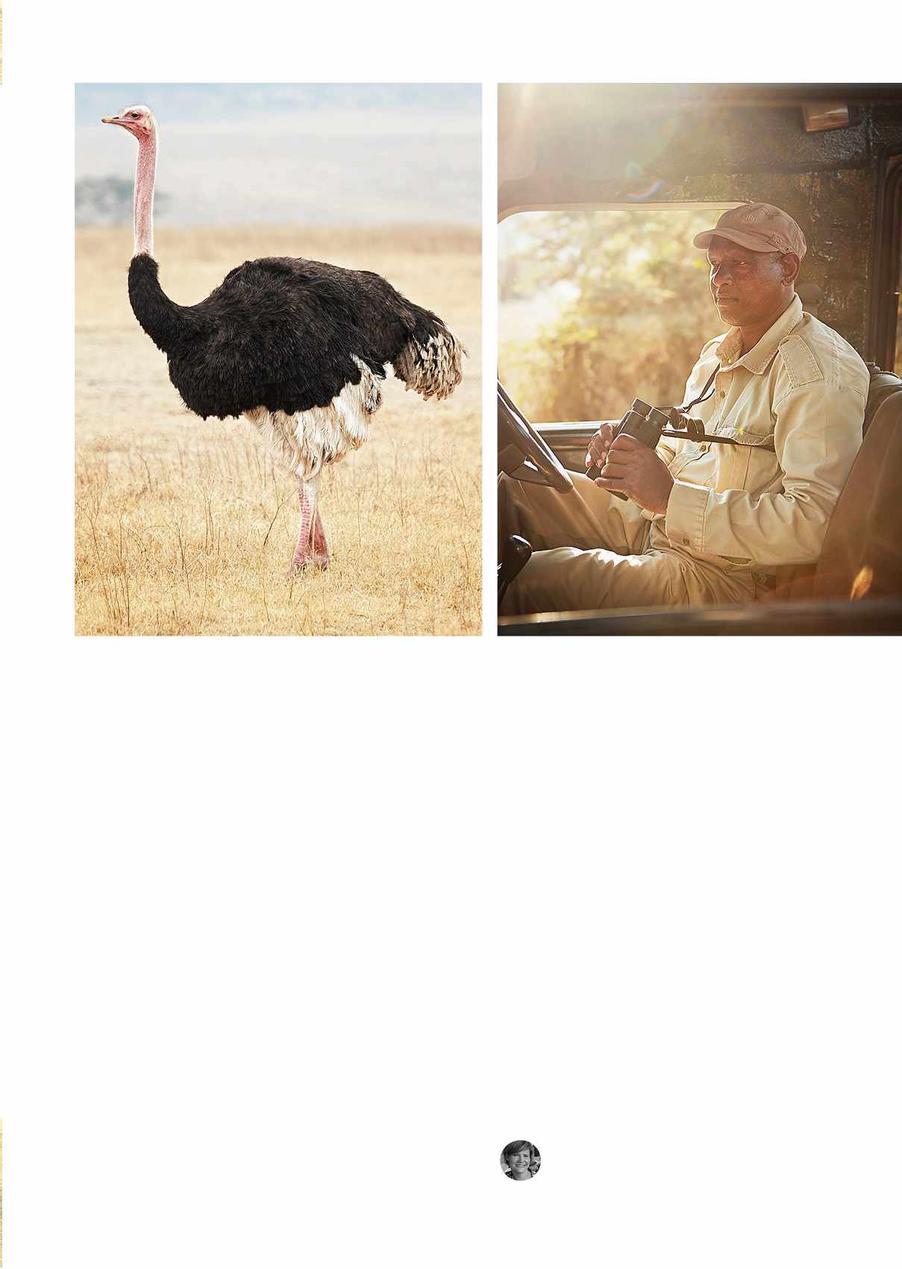
AMANDA CANNING is determined to see a rhino in the wild; she saw a very distant one in Ngorongoro, but isn’t entirely convinced it wasn’t a boulder.
Essentials Make it Happen
GETTING THERE The most convenient airport for northern Tanzania is Kilimanjaro International, near Arusha. Flights from the UK require a stop in Europe or Africa, and take at least 11 hours (from £520; klm.com).
GETTING AROUND You’ll need your own private transport to travel between the parks and lodges. Speak to your accommodation about arranging this, or organise through the tour operators mentioned on this page.
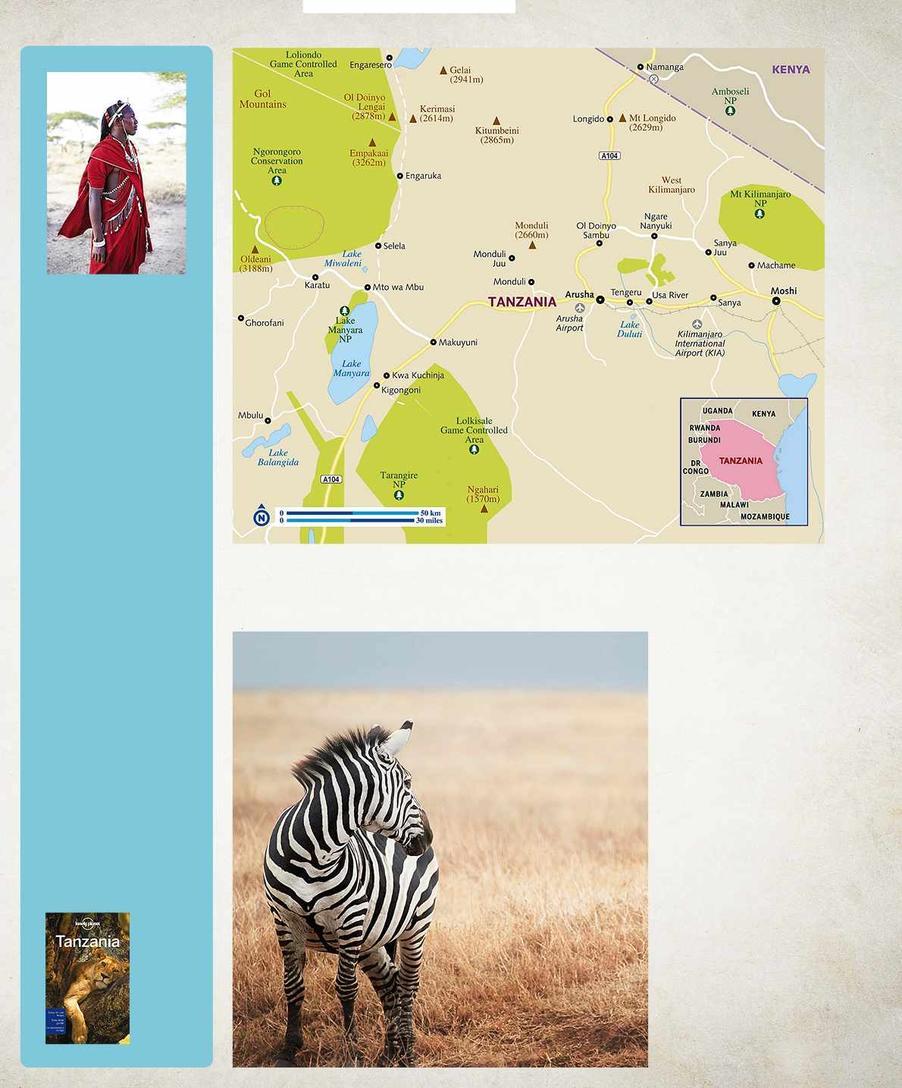
BEFORE YOU GO British citizens need a visa from the Tanzanian High Commission in London (£40; tanzania-online.gov. uk). Check that you’re up to date with vaccinations; a full list of requirements can be found at nathnac.org, including specific advice on yellow fever in the region.
FURTHER INFO Lonely Planet’s Tanzania guide has good coverage of the entire country (£16.99; lonelyplanet.com). MAP KEY
Amboseli (Kenya)
A watchful zebra in Ngorongoro Crater
Arusha National Park Momella Lakes Mount Kilimanjaro Mount Meru Ngorongoro Crater Ngurdoto Crater
TOUR OPERATORS
Organising your trip through an operator will take the hassle out of your travel arrangements, and may secure a discount on accommodation. Both of the operators below can arrange transfers betwen airports and lodges, as well as full trips. Takims is a local outfit with offers ranging from a four-day Northern Discovery tour taking in Ngorongoro and Arusha, to a 15-day trip that combines safari with a beach break on Zanzibar (from £690; takimsholidays.com). Go2 has itineraries across East Africa, with lots in Tanzania, from a circuit of the northern parks to forays into the lesser-visited western part of the country (£2,700 for an eight-day tour; theafricatravelspecialist.com).
Plan your itinerary
1 You’ll want a day to recover from your flight before exploring Arusha National Park, so book into HATARI LODGE (from £230pppn full-board with full-day game package; hatarilodge.de). The lodge has retro-styled rooms and a lovely walkway with firepit and views of passing buffalo and Mount Kilimanjaro. Meals are taken at a communal table.
3 Transfer to SHU’MATA CAMP in South Amboseli. The camp perches on a hill with terrific views of the surrounding plains and Mount Kilimanjaro (from £345pppn full-board with activities; shumatacamp. de). Guests sleep in luxury tents furnished in vintage safari style, with a whisky decanter on hand and an outdoor washing area for windswept ablutions. Staff here are truly lovely, and the atmosphere relaxed. Food is also a highlight. 2 There are many ways to fill your days at ARUSHA NATIONAL PARK. Hire a kayak and float with the flamingos on the Momella Lakes, climb up Mount Meru, follow a guide into Ngurdoto Crater or go on a game drive. Giraffes and zebra are easily spotted here. Activities can be arranged through Hatari.
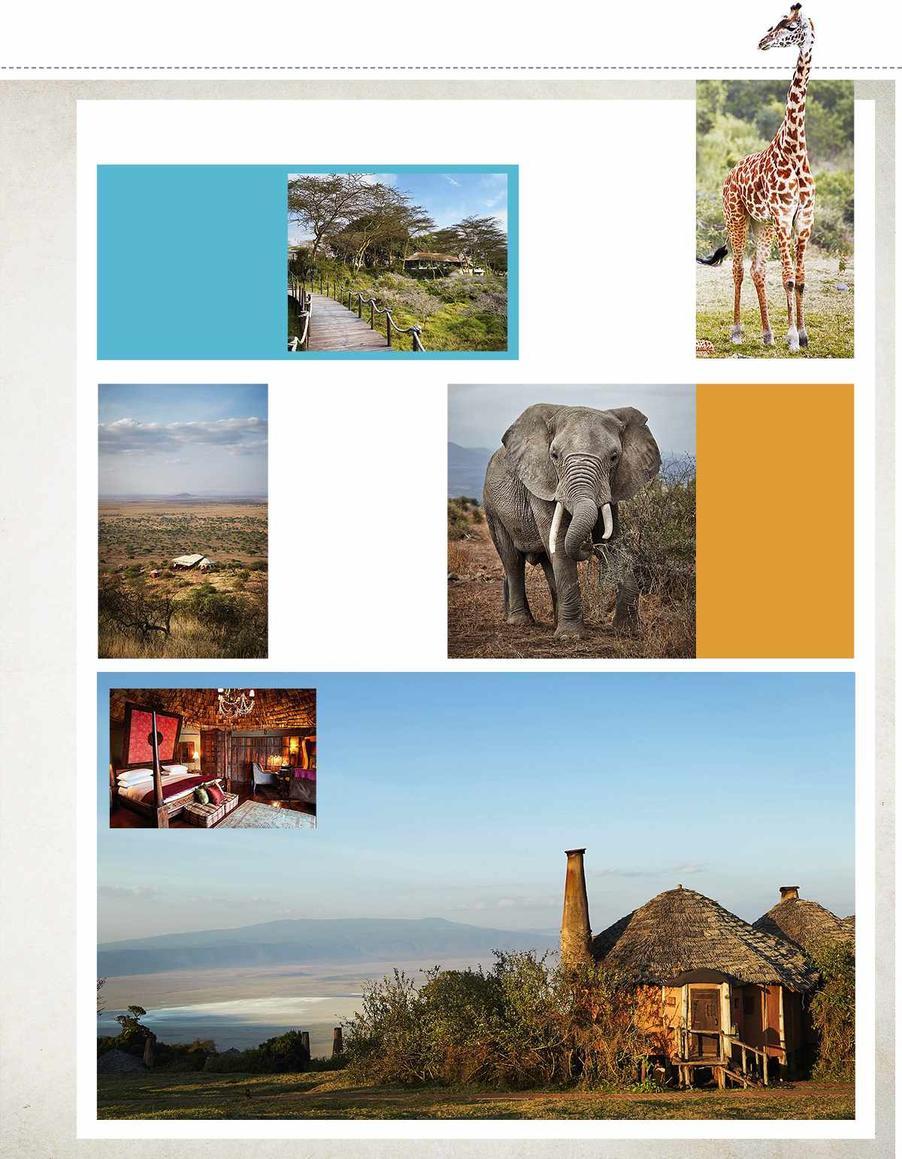
4 SOUTH AMBOSELI has great options for a whole host of varied experiences. Not to be missed are the crowd-free game drives that bring encounters with local elephants, giraffes and zebra. This is also a wonderful place to learn about Maasai culture, with naturalist walks and visits to local bomas (villages). Shu’mata will organise all activities, with transport and food provided.
5 Beg, borrow or steal for a chance to book in at NGORONGORO CRATER LODGE – it’s fairly likely to be the most spectacular place you’ve ever stayed in (from £680pppn full-board including safaris; andbeyond.com/ngorongoro-crater-lodge). The lodge sits on the very rim of the crater, with extraordinary views of the valley floor far below, and guests sleep in enormous stilted suites, each with their own terrace, sitting and dining areas. Meals and service here are exemplary (your private butler will have the fire lit and the bath poured before you realise you want both of these things very badly). Game drives into Ngorongoro, and the opportunity to spot lions, rhino and hippos, are included. The nearby town of Karatu has plenty of cheap accommodation; entry to the crater is £33pp plus £130 per vehicle (ngorongorocrater.org).








